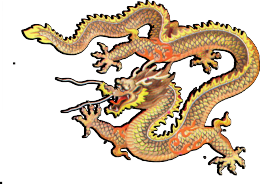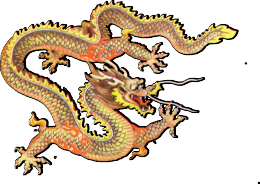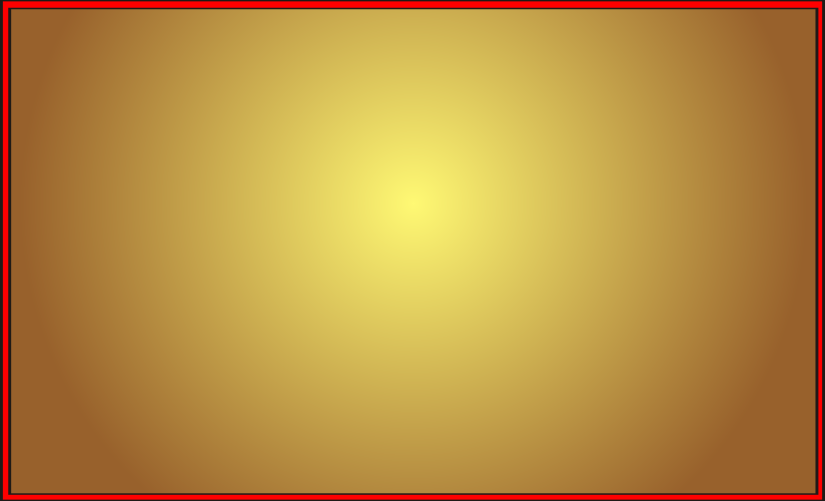

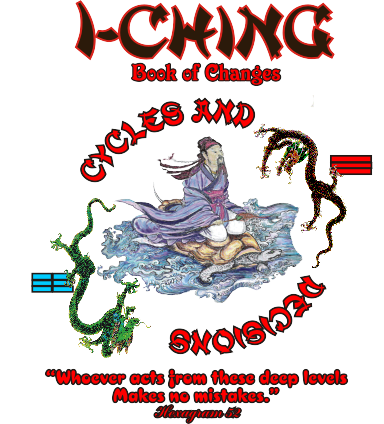
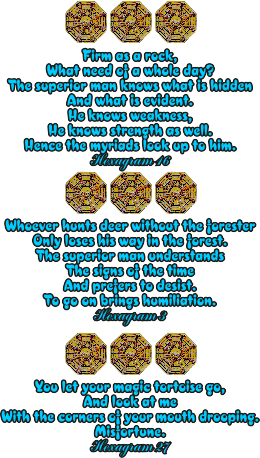
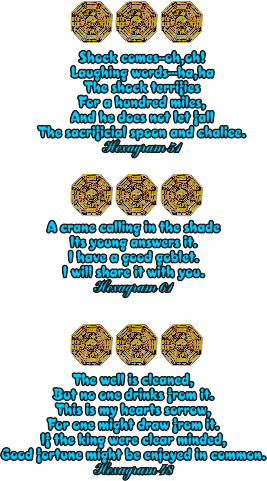
INTRODUCTION
FORMULATING A QUESTION FOR THE i-CHING
GUIDELINES FOR WRITING QUESTIONS
STRUCTURE OF THE I-CHING
CONSULTING THE ORACLE USING COINS
READING THE I-CHING
BACK TO BIO or HOME PAGE
![]() he I-Ching is one of the oldest books in existence. It is both an oracle and a Book of Wisdom. Its function as an oracle goes back to its very beginnings (2205 BC) when humankind’s relationship with nature was still intrinsic, and people saw the pattern of their lives and their destinies written in the signs of nature. The tortoise shell is the natural oracle most commonly referred to in the I-Ching. The I-Ching functioned originally as a simple yes/no oracle. Anyone who has ever flipped a coin to make a decision has consulted a yes/no oracle. The I-Ching portrays reality as being suspended between the two poles of yang and yin, ie. positive and negative. Life itself and the events of life are a continuous movement, an ebb and flow, between these opposite poles. I-Ching means “The Book of Changes”.
he I-Ching is one of the oldest books in existence. It is both an oracle and a Book of Wisdom. Its function as an oracle goes back to its very beginnings (2205 BC) when humankind’s relationship with nature was still intrinsic, and people saw the pattern of their lives and their destinies written in the signs of nature. The tortoise shell is the natural oracle most commonly referred to in the I-Ching. The I-Ching functioned originally as a simple yes/no oracle. Anyone who has ever flipped a coin to make a decision has consulted a yes/no oracle. The I-Ching portrays reality as being suspended between the two poles of yang and yin, ie. positive and negative. Life itself and the events of life are a continuous movement, an ebb and flow, between these opposite poles. I-Ching means “The Book of Changes”.
The I-Ching’s function as a Book of Wisdom has, like the layers of the Earth itself, been built up over time and is still building. Many wise people, and some not so wise, have had their hand in the forming and reforming of the I Ching. Confucius was one of its main interpreters and reformers. More recently Richard Wilhelm, contemporary and friend of Karl Jung, went to China as a Christian missionary and returned with his translation of China’s own gem of spiritual wisdom. This is the translation we use. Link to Amazon
The basic premise of the I-Ching is that there are no random events in the Universe. All events are a product of consciousness or thought. Therefore what takes place in the outer world is not the seeming coincidence and confusion that your surface mind would have you believe but is deeply connected with your innermost thoughts and realities. One of the big keys to understanding the problems and conflicts of life is to stop seeing them as isolated, unrelated incidents and understand where they fit into a comprehensive whole. This is what Karl Jung meant by “synchronicity”. Thus in consulting the I-Ching, you are shown how your problem fits into the whole. The I-Ching does not just show you how to solve a problem but how to grow from it.
We offer monthly I-Ching classes in which we provide basic instruction on how to consult the oracle, using the coin method, and how to interpret the material received. We emphasize that the most effective way to learn the I- Ching is to use it. Every class includes practical experience applying the I Ching to a submitted question. We have been consulting the I-Ching on a regular basis for the past 38 years. It acts as a wise guru that you can turn to for advice and guidance, and that is especially useful in times of conflict and stress. It operates as a sound and helpful “third party” in any conflict. From time to time we consult the I-Ching as part of our readings. We also offer assistance to others in how to interpret their I-Ching oracles.
Yin and Yang are the two poles of existence. These are the opposites of feminine and masculine, negative and positive, receptive and creative. Life itself never stands still but is continually moving back and forth between these two poles. Your very existence, as well as the events of your lives, personal and collective, also ebb and flow between these two poles. The I Ching, or The Book of Changes as it is known in English, is both built and formulated on this concept of Yin and Yang and their oscillation. It pictures and defines the ebb and flow of continual change and where you stand at any one moment in relation to it.
One of the big keys to understanding the problems and conflicts of your life, the people you relate to, your own thoughts and feelings, even future events is to stop seeing them as isolated, unrelated incidents. You need to understand where they fit into the Big Universe. Thus when you consult The I Ching, you are taking a question and being shown how your problem fits into the whole. The I Ching does not just show you how to solve a problem but how to grow from it.
Go to Top.
FORMULATING A QUESTION FOR THE I CHING:
![]() ORDING THE QUESTION: Any time you address The I Ching or any Yes-No Oracle, including the Coin Oracle (that's right, “heads or tails” has its own validity), the wording of the question requires careful thought. Don't ask silly questions! It is probably more appropriate to say don't be silly about your questioning. It is the approach or mindset that gets silly, not the question. Nothing actually lies outside of the realm of what The I Ching deals with. All of the physical world is a part of the spiritual world. It is only your mind that perceives a separation between these two worlds.
ORDING THE QUESTION: Any time you address The I Ching or any Yes-No Oracle, including the Coin Oracle (that's right, “heads or tails” has its own validity), the wording of the question requires careful thought. Don't ask silly questions! It is probably more appropriate to say don't be silly about your questioning. It is the approach or mindset that gets silly, not the question. Nothing actually lies outside of the realm of what The I Ching deals with. All of the physical world is a part of the spiritual world. It is only your mind that perceives a separation between these two worlds.
In writing a question you must first understand how The I Ching will approach that question. It refers often to “the superior man” and “the inferior man”and makes perfectly clear from which perspective you are assumed to view your world. It always addresses the superior man and never the inferior man. The I Ching also does not tolerate fools who "importune", i.e. persist in silliness (see Hexagram 4, "Youthful Folly"). "If he importunes, I give him no information." Actually, the wisdom is always there but you will not understand it if you persist in the silliness of “the inferior man”. Worse yet, you will probably misinterpret what you hear. To use the I Ching effectively, your questions must come from the highest that you know, i.e. THE SUPERIOR MAN.
The first step is to define and write your question. This will give clarity and definition to your answer. It also prevents you from deceiving yourself about what you asked, once you have seen the answer. The more you focus on the question, the greater the clarity you will find in the answer. This is why yarrow sticks are used in the East. They encourage a process of focus and meditation. Yarrow sticks are too slow for our western minds; hence the use of coins. However, if you are going to use the shortcut method and "throw fast", you still need to compose your mind. The formulation of the question must become the focusing device for the mind. You need to think about what you are trying to find out and why you want to know it. You need to become aware of all assumptions that lie behind your question and whether you are trying to ask multiple questions at once? The complexity of any search cannot be over emphasized. There are no simple yes-no answers. Every question is rooted deep in your psychology, present and karmic. A situation involving choice will contain many levels of polarized and often mutually exclusive outcomes. To get meaningful answers, the various levels and polarities must be respected and accounted for in the query. Thus, it is usually not just one question, but a series of questions that will make up your query. Your query often becomes a session with the I Ching, not just a question. The aforementioned statement in the hexagram, “Youthful Folly”, is often misinterpreted to mean you can ask only one question. If he is serious in his search, the I Ching will lead the superior man step by step through a series of questions to a greater understanding of his quest. The process of questioning is like turning a diamond to examine it facet by facet. Each question addresses the topic from a different perspective, adding new dimensions of understanding, until clarity is reached. This process can include asking the opposite or converse, and even sometimes returning to the original question, having gained a greater understanding of the parameters involved. It is wise to record each step of the process so you can go back and review the previous questions in the query and the answers given.
Go to Top.
GUIDELINES FOR WRITING QUESTIONS TO THE I CHING:
![]() Unless you are very clear about your issue, avoid black and white questions.
Unless you are very clear about your issue, avoid black and white questions.
A. Several ways to introduce a theme in an I Ching session:
1. Comment on this situation.
2. What is this about?
3. How should I view this situation?
4. How should I deal with this situation?
5. Should I be considering this choice or action?
B. A comment on your problem is often a good starting point.
1. “Comment on my relationship.” is better than “Should I dump this relationship?
a. It is not wise to reject a relationship without understanding it. You might ask:
(1) Why did I get into it?
(2) What is it showing me about myself?
(3) Why does it push my buttons?
(4) What did I bond myself to?
![]() Define and question all assumptions you are making and explore them with The I Ching. (This can be difficult because assumptions are by nature imbedded in your mindset.)
Define and question all assumptions you are making and explore them with The I Ching. (This can be difficult because assumptions are by nature imbedded in your mindset.)
A. A false assumption will lead, even with the most careful logic, to a false conclusion.
1. Problem: I need my independence from my family.
a. My father is a financial wizard.
b. My father says paying rent is a waste of money; I should be building equity.
c. I have to buy a house: paying rent is a waste of money; I should build equity.
d. Conclusion: I need to stay with my parents till I can buy my own place. Ugh!
2. Results:
a. So you live in an oppressive home setting, instead of owning your space and life by renting.
b. You spend some of your early formative adult years without independence.
c. If you are unsettled and choose to leave town, the house you bought becomes a millstone around your neck.
B. Start your query around what you want to know or see happen, not on the means of generating it.
1.” Comment on my desire to by a house?” is better than “How can I buy a house?”
2. The assumption in “How can I buy a house?” is that the purpose is valid and only the means is in question. (See also section II A)
3. The Universe has its own agenda and it is wise to be receptive to it.
4. One important lesson of “A Course in Miracles” is “I do not know my own best interest.”
![]() A situation involving choice will contain many levels of polarized and often mutually exclusive outcomes.
A situation involving choice will contain many levels of polarized and often mutually exclusive outcomes.
A. Work from the general to the more specific.
1.The problem will always contain a “mythic image” or life lesson as well as a physical
challenge. This should be addressed first. It is therefore often better to start with a comment and then follow up with more specific questions as The I “Ching directs you.
2. First ask: “Comment on my car problem”, then ask:
a. Should I repair my car?
b. Should I buy a new car?
c. Should I buy this car?
B. Do not include multiple levels of query in one question.
1. “Should I quit my job or leave Pennsylvania? is asking all of the following at once.
a. Am I running from this problem?
b. Should I confront my boss or co worker.
c. Should I quit my job and stay where I am?
d. Should I keep my job and transfer to another department or location.
e. Should I quit my job and move in or out of Pennsylvania?
C. Do not include both polarities of the query in the same question.
1. Should I go to the beach for vacation or stay at home and fix the house?
2. And if The I Ching gives you a resounding “yes”, then what?
![]() Determine what for you is the more desirable outcome.
Determine what for you is the more desirable outcome.
A. You want the positive statements to coincide with what you see as desirable.
1. Word your question so that the positive responses depict the desired outcome.
a. Is he cheating on me?
(1) How can you reconcile a glowing line with “Yes he is cheating on me.”?
b. Is he being faithful to me?
(1) Now a reassurance from The I Ching will let you sleep at night.
![]() When The I Ching seems to make no sense, examine your question for each of the aforementioned problems.
When The I Ching seems to make no sense, examine your question for each of the aforementioned problems.
![]() The I Ching will always give a wise answer but if you cloud the question with fuzzy thinking how can you grasp its meaning?
The I Ching will always give a wise answer but if you cloud the question with fuzzy thinking how can you grasp its meaning?
Most of these questions about life situations have a divinatory element in them. When the intent of any question is directed only toward a worldly solution, it (i.e. “What should I do?”) becomes the domain of the inferior man. The inferior man seeks success in the world, and The I Ching cares not for him or his worldly estate. The I Ching addresses the superior man and his search for wisdom. Thus The I Ching can send you down dead end roads where the only success is the knowledge of self. Do not be surprised or disappointed because therein lies your greatest wealth.
In most cases the images in The I Ching should be read as metaphors, but there are occasions when it can also be astoundingly literal. Once when asking The I Ching if we should provide transportation for a friend, we received the line which says “The axle trees are taken from the wagon” We didn’t have a clear picture of what it was addressing but chose not to provide taxi service. Shortly before the event in question our car axle broke and it would have been impossible. In retrospect it is clear that we were driven by an inappropriate compulsion to serve. The consequent overload broke our axle. Even though we chose not to act it out, the unhealed, unconscious compulsion to serve and its resultant load on the psyche still broke the axle.
We needed the broken axle to grasp the problem and grow from it. Then there is cause for celebration. Go to Top.
![]() he I Ching is composed of 64 hexagrams, that is: 64 written symbols with their ensuing body of meaning. Each one is made up of 6 lines, a mixture of yin and yang , or all yin in the case of hexagram 2, The Receptive , and all yang in the case of hexagram 1, The Creative .
he I Ching is composed of 64 hexagrams, that is: 64 written symbols with their ensuing body of meaning. Each one is made up of 6 lines, a mixture of yin and yang , or all yin in the case of hexagram 2, The Receptive , and all yang in the case of hexagram 1, The Creative .
There are 8 trigrams (each with 3 lines). It is the different combinations of these 8 trigrams that form the 64 hexagrams (i.e. 8x8). Each trigram is part of a family relationship and is also associated with an image from nature, as well as having a defining attribute.
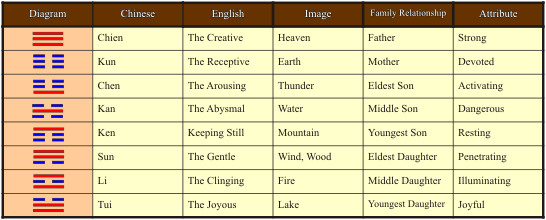 Each of the 64 Hexagrams is made up of a combination of two of the above trigrams.
Each of the 64 Hexagrams is made up of a combination of two of the above trigrams.
Go to Top
CONSULTING THE ORACLE USING COINS:
![]() or the coin oracle 3 coins are thrown simultaneously to determine each of the six lines of the hexagram. (Any head-tail coin or object may be used.) All tails are given a value of 2, and all heads are given a value of 3. There are 4 possible combinations for any line on a single throw of the coins.
or the coin oracle 3 coins are thrown simultaneously to determine each of the six lines of the hexagram. (Any head-tail coin or object may be used.) All tails are given a value of 2, and all heads are given a value of 3. There are 4 possible combinations for any line on a single throw of the coins.

You can see that the odd numbers 7 and 9 are yang ![]() , and the even numbers 6 and 8 are yin
, and the even numbers 6 and 8 are yin ![]() . The numbers 6
. The numbers 6 ![]() and 9
and 9 ![]() have an exceptionally strong energy behind them (all three coins are the same) so they move i.e., reverse their polarity from yin
have an exceptionally strong energy behind them (all three coins are the same) so they move i.e., reverse their polarity from yin ![]() to yang
to yang ![]() or yang
or yang ![]() to yin
to yin ![]() respectively and a new hexagram is formed. The moving lines are marked with an X for yen
respectively and a new hexagram is formed. The moving lines are marked with an X for yen ![]() or a O for yang
or a O for yang ![]() to denote their special energy.
to denote their special energy.
Each line is recorded one above the other. The trigram builds from the bottom up. If you forget and record it below instead of above, building it from the top down or make other mistakes such as dropping a coin on the floor etc., accept its validity as it is. It is the nature of an oracle to reflect you, so any technical mistakes in the process are automatically adjusted for. However, to keep within the tradition, practice building your hexagram from the bottom up; otherwise, as in life, you become ungrounded.
If any lines are moving (number 6, formed by 3 tails, number 9, formed by 3 heads) a new hexagram is formed from those lines which changed and those which did not. If there are no moving lines there will not be a second hexagram. It is possible for any number of the lines to change therefore any hexagram can change into any other depending on which lines are moving.
Each hexagram is composed of two trigrams: The Upper Trigram, and The Lower Trigram. The pattern of the lines of each trigram is depicted on the fold-out table at the back of the Wilhelm edition of The I Ching.

The line pattern of the upper Trigram is located in the row of the eight possible trigrams across the top of the page. The line pattern of the lower trigram is located in the left column of the page. Like a bus schedule the horizontal row of the upper trigram Kun and the vertical column of the lower trigram Tui intersect at 19. Therefore 19 Approach is the first hexagram. The second hexagram is treated in the same way and you find it is 24 Return. Go to Top.
READING THE I CHING:
![]() he I Ching is divided into 3 parts: Book I, The Text which contains the 64 hexagrams; Book II, The Material and The Great Treatise, the evolution of thought that is behind the I Ching: and Book III, The Commentaries, comments and further explanations of the meanings and derivations of the symbolism within the individual hexagrams.
he I Ching is divided into 3 parts: Book I, The Text which contains the 64 hexagrams; Book II, The Material and The Great Treatise, the evolution of thought that is behind the I Ching: and Book III, The Commentaries, comments and further explanations of the meanings and derivations of the symbolism within the individual hexagrams.
Book I, The Text, is the starting point for any query. Find the nu mber of the hexagram you have derived in the text. Each hexagram is composed of an introduction, The Judgement which is a direct statement about the meaning and advice of the hexagram, and The Image which is a picture of the interaction of the two trigrams with each other and The Lines which are extra comments to be read if there are moving lines. The introduction, judgment and image are always to be read when addressing a question.
mber of the hexagram you have derived in the text. Each hexagram is composed of an introduction, The Judgement which is a direct statement about the meaning and advice of the hexagram, and The Image which is a picture of the interaction of the two trigrams with each other and The Lines which are extra comments to be read if there are moving lines. The introduction, judgment and image are always to be read when addressing a question.
Each line is a further poetic statement about the problem, followed by a commentary. Only those lines which are moving in the hexagram should be read. Note that the lines start from the bottom and count upward with the final line at the top. The hexagram and the moving lines constitute the main body ofTthe I Ching’s advice on the question and should be seriously pondered.
The following hexagram is the progression or resolution of energies as when a corner is turned, and should be read after a full exploration of the first hexagram has been made.
![]()
f the answer is still not clear, further questioning may be respectfully asked to clarify the picture. It is like turning a diamond to observe the reflection of its facets from many angles. It is often useful to ask the opposite question to get more clarity. It must be remembered, however, that “mistrustful and unintelligent questioning” will be answered with Hexagram 4, Youthful Folly: “At the first oracle I inform him. If he asks two or three times, it is importunity. If he importunes, I give him no information.” It is not that it gives no information, it is that we are no longer receptive to its message. The nature of the oracle is that it always offers wisdom. We are often not ready to listen
INTRODUCTION
FORMULATING A QUESTION FOR THE i-CHING
GUIDELINES FOR WRITING QUESTIONS
STRUCTURE OF THE I-CHING
CONSULTING THE ORACLE USING COINS
READING THE I-CHING
BACK TO BIO or HOME PAGE
